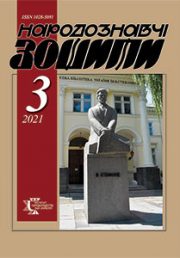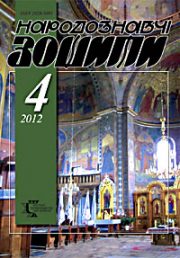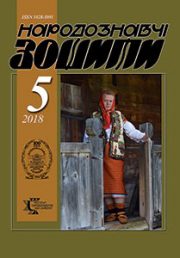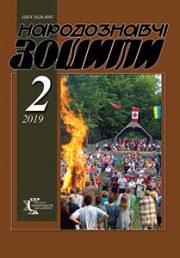The Ethnology Notebooks. 2020. № 1 (151), 117—125
UDK745.51.011.26.071.1(477.85/.87-22)”19″
DOI https://doi.org/10.15407/nz2020.01.117
RICHKA MASTERS OF INLAYON WOOD. FOLLOWING TRADITIONS AND FORMALISM OF FOLK ART
CHIKH-KNYSH Bohdana
ORCID ID: https://orcid.org/0000-0002-4137-4493
Candidate of Arts (Ph. D)
postdoctoral, Lviv National
Academy of Art; associate professor,
Department of Art History and Humanities,
Kosiv State Institute of Decorative and Applied Art LNAA
32 Stephan Bandera str.,
Kosiv, Ivano-Frankivsk region, 78600, Ukraine
Contacts: e-mail: bogdana1973@gmail.com
Abstract. The Hutsul village of Richka is a unique modern center of wood carving and inlay. During the 20th century a special artistic style has been formed here, which is now considered to be traditional. The study of the specificity of forms and ornamental decoration of wooden wares is of vital importance. The aim of the study is to identify the traditional and new aesthetic features of anartistic process, to find out the factors and grounds for formalism in folk art. The object of the study is the wooden wares of Richka masters, and the subject is the artistic features and the process of interpenetration of traditional and new aesthetic characteristics of the folk art of Hutsulshchyna. The methodological basis of the research is the historically systematic analysis of the cultural context, a comparative characteristic based on art analysis. The basiс sources of research are the examples of inlaid wooden wares stored in museum collections and owned by the folk craftsmen of the village of Richka. Fact-based material was recorded during field expeditions and from the published works of art critics A. Budzan, M. Stankevych, O. Solomchenko.
The exhibition «The Virtuosos of Inlay», which was going on at the Kosiv Museum of Folk Art and Way of Life of Hutsulshchyna during December 7—20, 2018, proved that contemporary Richka masters still work productively. Nine carvers from the village of Richka: Vitalii Martyshchuk, Vasyl Shmadiuk, Mykhailo Kishchuk, Oleksii Kishchuk, Petro Kishchuk, Ivan Bilak, Vasyl Sharaburiak, Mykola Grepyniak and Vasyl Grepyniak presented inlaid wooden wares with distinctive local style.
The inlay with wood of different colors and tone,pearls and beads is typical of wares of modern Richka masters. The surfaces of the inlaid wooden wares are smooth, the forms are laconic. Ornamental compositions of geometric forms are overloaded with various details and inlaid elements. The wooden wares of modern masters of the village of Richka are highly decorative, with indistinctly turned forms, their authors try to follow the traditional ornaments, use inlay with different materials. Excessive decoration is often not justified — colorful ornaments do not go well with the form, have no rhythm of composition. In general, one can notice similar pattern of compositions and the formal use of the means of decoration. However, among a large number of contemporary Richka masters’ wooden wares one can find artistic samples that deserve continuation of Hutsul traditions.
Keywords: folk masters, tradition, formalism, inlay.
Received 13.01.2020
REFERENCES
Shukhevych, V.O. (2018). Hutsulshchyna (Vol. 2). Kharkiv: Oleksandr Savchuk [in Ukrainian].
Budzan, A.F. (1960). Wood carving in the western regions of Ukraine. Kyiv: Vydavnytstvo AN Ukrainskoi RSR [in Ukrainian].
Solomchenko, O. (2010). Marko Mehedyniuk (Pp. 137—150). Kosiv: Pysanyi Kamin [in Ukrainian].
Stankevych, M.Ye. (2002). Ukrainian artistic wood. Lviv: Instytut narodoznavstva NAN Ukrainy [in Ukrainian].
De Moran, A. (1982). The history of decorative and applied art. Moskva: Iskusstvo [in Russian].
Siredzhuk, P. (1999). From the chronicle of the settlement of Halych Hutsulshchyna. In М. Domashevskyi. The history of Hutsulshchyna (Vol. IV, pp. 124—150). Lviv: Logos [in Ukrainian].
Molyn, V.D. (2013). An outstanding master Marko Mehedyniuk. Visnyk LNAM (Issue 23, pp. 228—236) [in Ukrainian].
Domashevskyi, M. (1995). Artistic wood carving. In М. Domashevskyi. The history of Hutsulshchyna (Vol. I, pp. 245—290). Lviv: Logos [in Ukrainian].







